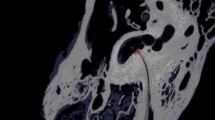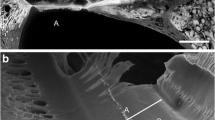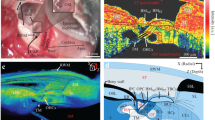Abstract
The morphologic features of the human cochlear aqueduct were examined using both light and electron microscopy. The lumen of the cochlear aqueduct was observed to be filled with dense, irregular connective tissue corresponding to dura mater. At the entrance to the cerebrospinal fluid space, the dense connective tissue in the ductal lumen was covered with a thin layer of a few flattened cells, which was contiguous with the arachnoid membrane of the brain. A simple low cuboidal epithelium also separated the perilymphatic space from the lumen of the duct. Our observations confirm the presence of a barrier membrane at the opening to the perilymphatic space, and suggest that no transport occurs in the human cochlear aqueduct.
Similar content being viewed by others
References
Alcolado R, Weller RO, Parrish P, Garrod D (1988) The cranial arachnoid and pia mater in man: anatomical and ultrastructural observations. Neuropathol Appl Neurobiol 14:1–17
Anson BJ, Donaldson JA, Warpeha RL, Winch TR (1965) The vestibular and cochlear aqueducts: their variational anatomy in the adult human ear. Laryngoscope 75:1203–1223
Carlborg B, Farmer JC (1983) Transmission of cerebrospinal fluid pressure via the cochlear aqueduct and endolymphatic sac. Am J Otolaryngol 4:273–282
Carlborg B, Densert B, Densert O (1982) Functional patency of the cochlear aqueduct. Ann Otol Rhinol Laryngol 91:209–215
Fawcett DW (1986) Epithelium. In: Fawcett DW (ed) A textbook of histology, 11th edn. Saunders, Philadelphia, pp 57–82
Karlefors J (1927) Die Hirnhautraume des Kleinhirns, die Verbindungen des 4. Ventrikels mit den Subarachnoidalraumen und der Aqueductus Cochlear beim Menschen. Acta Otolaryngol (Stockh) [Suppl] 4:1–184
Kelemen G, Fuente ADL, Olivares FP (1979) The cochlear aqueduct: structural considerations. Laryngoscope 89:639–645
Linsay JR, Schuknecht HF, Nefe WD, Kimura RS (1952) Obliteration of the endolymphatic sac and cochlear aqueduct. Ann Otol Rhinol Laryngol 61:697–716
Nabeshima S, Reese TS, Landis DMD, Brightman MW (1975) Junctions in the meninges and marginal glia. J Comp Neurol 164:127–170
Palva T (1970) Cochlear aqueduct in infants. Acta Otolaryngol (Stockh) 70:83–94
Palva T, Dammert K (1969) Human cochlear aqueduct. Acta Otolaryngol (Stockh) [Suppl] 246:1–57
Rask-Andersen H, Stahle J, Wilbrand H (1977) Human cochlear aqueduct and its accessory canals. Ann Otol Rhinol Laryngol [Suppl] 42:1–16
Retzius G (1884) Das Gehörorgan der Säugetiere und des Menschen. In: Retzius G (ed) Das Gehörorgan der Wirbeltiere, vol 2. Samson and Wallin, Stockholm, pp 206–368
Ritter FN, Lawrence M (1965) A histological and experimental study of cochlear aqueduct patency in the adult human. Laryngoscope 75:1224–1233
Schuknecht HF, Reisser C (1988) The morphologic basis for perilymphatic gushers and oozers. Adv Otorhinolaryngol 39: 1–12
Schuknecht HF, Seifi AE (1963) Experimental observations on the fluid physiology of the inner ear. Ann Otol Rhinol Laryngol 72:687–712
Toriya R, Arima T, Kuraoka A, Uemura T (1991) Computer-aided three-dimensional reconstruction of the guinea pig cochlear aqueduct. Acta Otolaryngol (Stockh) 111:917–920
Toriya R, Arima T, Kuraoka A, Uemura T (1991) Ultrastructure of the guinea pig cochlear aqueduct: an electron microscopic study of decalcified temporal bones. Acta Otolaryngol (Stockh) 111:699–706
Warwick W, Bannister D (1989) The meninges. In: Warwick W (ed) Gray's anatomy, 37th edn. Churchill Livingstone, New York, pp 1086–1092
Wlodyka J (1978) Studies on cochlear aqueduct patency. Ann Otol Rhinol Laryngol 87:22–28
Author information
Authors and Affiliations
Rights and permissions
About this article
Cite this article
Toriya, R., Arima, T., Kuraoka, A. et al. Fine structure of the human cochlear aqueduct: a light and transmission electron microscopic study of decalcified temporal bones. Eur Arch Otorhinolaryngol 251 (Suppl 1), S38–S42 (1994). https://doi.org/10.1007/BF02565217
Received:
Issue Date:
DOI: https://doi.org/10.1007/BF02565217




